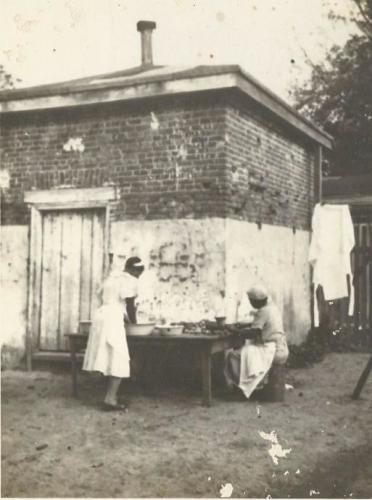When I embarked on my journey to learn more about African American history in the place I’ve called home since 2014, I discovered numerous contributions of Blacks and stories of resilience. African Americans’ impact can be seen in every era from the Civil War to Civil Rights. Here are ways to engage with this rich history during your visit.
Gullah Geechee Heritage: Cultural Connections to the Past
The Gullah Geechee people are descendants of enslaved West Africans who maintained their unique culture in North America. The National Park Service’s Gullah Geechee Cultural Heritage Corridor begins just north of Wilmington and extends along the coastal areas of the Carolinas, Georgia and Florida. One stop in the corridor where visitors can delve into the history and culture of the Gullah Geechee people is Poplar Grove Plantation, a former sweet potato and peanut plantation. Now a museum, it offers tours detailing the history of the West African peoples and highlighting North Carolina Black History through the American Revolution and the Civil War as it relates to people who were enslaved at the plantation.

Poplar Grove Plantation 1934
The Bellamy Mansion Museum of History & Design is another Wilmington site on the Gullah Geechee Cultural Heritage Corridor. Visitors can tour the historic home’s original slave quarters – one of the best-preserved examples in the country.
Other ways to experience this unique culture include art and foodways. African-and Gullah-inspired art by North Carolina artists Ivey Hayes and Harry Davis are located at the University of North Carolina Wilmington’s (UNCW) Fisher University Union and Upperman African American Cultural Center. Visitors can even sample culturally-inspired dishes at Catch, a restaurant owned by official Gullah culinarian Chef Keith Rhodes, a James Beard semi-finalist for Best Chef, Southeast.
Civil War: Bear Arms for Freedom
The U.S. Colored Troops (USCT) fought in the final stages at Fort Fisher in nearby Kure Beach and then trekked 17 miles to Wilmington to fight the Confederates in the Battle of Forks Road Feb. 20-21, 1865. The USCT-won battle, which took place on the grounds where the Cameron Art Museum sits today, led to the Union Army capturing Wilmington, a pivotal point in the Civil War which ended a month later. Spend some time at the nation’s first United States Colored Troops Park. Located at the museum, it serves as a quiet place for reflection and remembrance of the USCT soldiers. Guests can view the park’s public sculpture Boundless, which honors the freedom fighters and their legacy. Stephen Hayes, the artist who sculpted Boundless, cast USCT descendants, historical reenactors, veterans and community leaders to bring the life-size bronze sculpture to life. Visitors can watch demonstrations during the museum’s Battle of Forks Road Living History Commemoration held annually in February.
Learn more about Civil War history in Wilmington by visiting historic site markers like the Orange Street Landing at Cape Fear, a National Underground Network to Freedom site, which honors enslaved plasterer William B. Gould who escaped in 1862 and joined the Union Navy. The N.C. Highway historical marker near the Wilmington National Cemetery honors the role of the USCT. Or, visit Cape Fear Museum of History & Science to tour its signature exhibit Cape Fear Stories, which interprets the region’s rich and complex history, including the experiences of enslaved African Americans.
Reconstruction & Beyond: 1898 Massacre & Coup and its Aftermath
Following the Civil War, many of the troops who fought in the USCT settled down in Wilmington to raise their families and create a life for themselves with the newfound freedom they bravely fought to obtain. Wilmington’s African American community was thriving with a growing middle class and many Black citizens held government positions – ranging from city councilmen to city attorneys. On Nov. 10, 1898, white supremacists murdered many Black residents and deposed the city’s multiracial government. The 1898 Wilmington Massacre was the only successful coup d’état in American history. Today, visit the 1898 Monument & Memorial Park and the Cape Fear Museum of History, or book a tour on-demand with WilmingtoNColor Heritage Tours or Journey Wilmington African American History Tours to learn more about the horrific events of the massacre. The self-guided Wilmington History Tours African American History app also includes 1898 landmarks.
Civil Rights Era: The Fight for Equity and Equality
UNCW’s The Civil Rights Movement in Southeast North Carolina digital collection provides an overview of significant events, including Dr. Hubert A. Eaton’s desegregation efforts and the wrongful convictions of the Wilmington Ten. Visit UNCW’s Randall Library to view its archives. New Hanover County’s digital Greenbook Guide explores safe locations that African American motorists sought during the Jim Crow Era. Wilmington’s African American history tours also include stops at historically significant Civil Rights sites.
21st Century – Present: Commemorating the Past to Move Forward
Community gatherings, exhibits and commemorations are held throughout the year to remember the past, engage in healing conversations and move forward together.
Notable Black trailblazers and 1898 massacre victims are buried in Pine Forest Cemetery, including Joshua Halsey, whose unmarked grave was discovered in March 2021. A public funeral was held 123 years after his death, and a headstone now marks his resting place.

Be sure to make time to visit UNCW’s campus and see Because It’s Time, a Black Lives Matter sculpture by N.C. artist Dare Coulter. The sculpture honors Black Lives in Wilmington and the Gullah Geechee culture. It can be found near the amphitheater in front of Fisher University Union.
Additional tours are available for visitors to explore the area's African American history from pre-Civil War through today. To find more details, check out the Wilmington and Beaches Guide to African American History.


